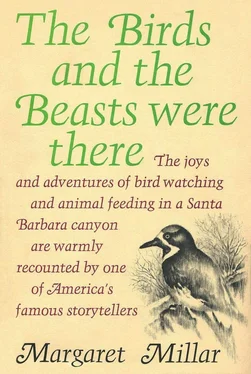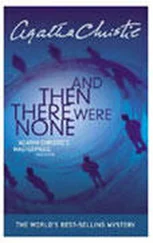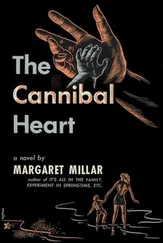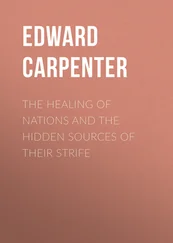Маргарет Миллар - The Birds and the Beasts Were There
Здесь есть возможность читать онлайн «Маргарет Миллар - The Birds and the Beasts Were There» весь текст электронной книги совершенно бесплатно (целиком полную версию без сокращений). В некоторых случаях можно слушать аудио, скачать через торрент в формате fb2 и присутствует краткое содержание. Город: New York, Год выпуска: 1967, Издательство: Random House, Жанр: Природа и животные, на английском языке. Описание произведения, (предисловие) а так же отзывы посетителей доступны на портале библиотеки ЛибКат.
- Название:The Birds and the Beasts Were There
- Автор:
- Издательство:Random House
- Жанр:
- Год:1967
- Город:New York
- ISBN:нет данных
- Рейтинг книги:4 / 5. Голосов: 1
-
Избранное:Добавить в избранное
- Отзывы:
-
Ваша оценка:
- 80
- 1
- 2
- 3
- 4
- 5
The Birds and the Beasts Were There: краткое содержание, описание и аннотация
Предлагаем к чтению аннотацию, описание, краткое содержание или предисловие (зависит от того, что написал сам автор книги «The Birds and the Beasts Were There»). Если вы не нашли необходимую информацию о книге — напишите в комментариях, мы постараемся отыскать её.
The Birds and the Beasts Were There — читать онлайн бесплатно полную книгу (весь текст) целиком
Ниже представлен текст книги, разбитый по страницам. Система сохранения места последней прочитанной страницы, позволяет с удобством читать онлайн бесплатно книгу «The Birds and the Beasts Were There», без необходимости каждый раз заново искать на чём Вы остановились. Поставьте закладку, и сможете в любой момент перейти на страницу, на которой закончили чтение.
Интервал:
Закладка:
In the course of the morning a number of the usual birds came to the ledge to feed — house finches, a pair of young song sparrows, cowbirds and blackbirds, a lone flicker and a mockingbird. The scrub jays remained absent, as did the band-tailed pigeons, the three species of dove and two house wrens who’d been with us since spring. We never saw any of them again.
When a major disaster is over, there are immediate estimates of losses in terms of dollars and cents. The Coyote fire, which continued for more than a week, is said to have been started by a woman burning rubbish to avoid the admission fee to the county dump. She saved fifty cents. It cost the rest of us $20,000,000.
The cost in wildlife was much more difficult to assess. The creatures given sanctuary by the Humane Society ranged from African goats to ducks and peacocks, but these were pets. Reports of actual wildlife, especially of birds, were few and vague. An account of birds flying up out of the burning trees and falling back into the flames, I was unable to verify — let alone check what kinds of birds and whether they were all the same and how many there were, and so on. The number of injured birds brought to the Museum of Natural History was no higher during and after the fire than before it.
Bill Botwright of the Santa Barbara News-Press, describing his patrol of the fire area during the first night’s lull when the santana stopped, told of seeing “two large birds blundering blindly in the red glare.” He thought they were crows, but they could have been band-tailed pigeons which are only slightly smaller, fourteen to sixteen inches as compared with the crows’ seventeen to twenty-one inches. Dick Smith, of the same newspaper, who covered the rugged back-country regions in his triple roles of artist, topographer and naturalist, told us that the only birds he saw actually fleeing the fire were quail running out of the underbrush, and that on dozens of trips into the area after the fire he didn’t come across a single carcass or skeleton of a bird. This doesn’t mean that no birds were destroyed, only that evidence of such destruction was reduced to ash. Bird bones are light and hollow; they can be, and often by accident have been, cremated in a backyard barbecue pit.
In the absence of eyewitness accounts and even one corpusdelicti , we had to depend on circumstantial evidence as well as facts. The main fact was that before the fire we had feeding on our ledge every day a flock of approximately a hundred band-tailed pigeons, half that many mourning doves, one white-winged and one turtle dove, ten or twelve scrub jays; and feeding in and under the shrubbery around the house, a pair of house wrens. None of these birds reappeared after the fire. (Our last sight of the Vaux’ swift on the first night of the fire has been described in an earlier chapter.)
A number of people have suggested that the disappearing birds sensed danger and flew away to a safer area. There are several reasons why I can’t believe this. If the pigeons, doves and jays took flight when danger was imminent, why didn’t the house finches, towhees, blackbirds, cowbirds, song sparrows, goldfinches, hummingbirds, thrashers, titmice, flickers and so on?
You would also expect that when the danger had passed, the birds that had fled would begin returning. The feeding station was their home, as far as wild birds can have a home. There they ate their meals and met their neighbors, and sunned in the good weather and took shelter in the bad. Many of them had been brought to the ledge the first day they could fly and they accepted Ken and me and the three dogs, moving around on the other side of the glass or on the patio below, as part of their daily routine. I have previously described the tameness of the jays. As for the doves and pigeons, they had become so unafraid that it took several smart taps of a folded newspaper on the window or the porch railing to chase them away when I wanted to turn on the rainbirds. Even then an occasional juvenile would refuse to budge, and would stand glaring at me through the bogus rain with an expression that clearly meant, who did I think I was — the owner of the ledge?
If any of the missing birds had come back I would have recognized them instantly, not as individuals but as former freeloaders who knew their way around the premises. Newcomers arriving at the feeding station were easy to spot.
A very small minority of these were stragglers too hungry, too exhausted or too sick to act in their normally cautious manner. The rose-breasted grosbeak which appeared on October 30, 1963, was a good example. This grosbeak, a bird belonging east of the Rockies, must have been somewhat flabbergasted to find himself not only west of the Rockies, but west of the Sierra Nevada as well; in fact, right at the Pacific coast on our ledge. He ate almost continuously the first day, oblivious to the other birds and to the movements of people on the other side of the window, including a flock of birdwatchers who’d responded to the Rare Bird Alert I had put out as soon as the grosbeak arrived. On the second day he was considerably more skittish and his appearances on the ledge were so sporadic that one determined out-of-town birder had to wait two hours for a glimpse of him. By the fourth day, rested, well fed and in good health again, he was completely wild and independent, and that afternoon he was on his way.
The rose-breasted grosbeak had reversed the usual behavior pattern. Normally a new bird arrives shy and wild and gradually becomes tamer. The first Brewer blackbird, for instance, approached the feeding station quietly and by himself. From an unobtrusive perch in the loquat tree he studied the proceedings for more than a week before he flew down with the other birds, at first on the lower terrace, eventually on the ledge.
The most extreme case of wariness was the crow. He spent an entire winter watching the place from the tops of the eucalyptus trees and the Monterey pines. The opening of a door or window, the turning on of a sprinkler, the slightest movement that was unexpected would send him flying off, squawking invectives at us and warnings to his friends. Only when there were babies to be fed did he come down for food. He was so quick and quiet about it that I didn’t even suspect he was responsible for the whole doughnuts disappearing as soon as I put them out in the wooden dish outside my office window. Though I had no evidence against the scrub jays, I blamed them, on general principles. Then one morning when I went into my office to begin work, a black flash crossed the corner of my vision and the thief was identified. I duly apologized to the jays, who are blamed by nearly everybody for nearly everything.
The crow and the rose-breasted grosbeak provided good examples of the two types of behavior which made newcomers to the feeding station easily recognizable.
The first band-tailed pigeon to arrive after the fire showed no signs of familiarity with the place. He perched, just as our initial bandtail had done years previously, on a eucalyptus limb over the drip birdbath. When I went over to the window and raised my binoculars he flew away. Shadows on windows couldn’t be trusted and binoculars were weapons that might be used against him. He was a stranger. So, too, was the first scrub jay after the fire, and the first mourning dove. No white-winged dove, turtle dove or house wren appeared again at the feeding station.
What had happened? We can never be completely sure, but there seems little doubt that the missing birds were destroyed while they were asleep. Once birds are settled for the night they are hard to disturb. Eyes closed, heartbeat slowed, head tucked under wing and claws locked in position, the sleeping bird is practically oblivious to noise, light and movement: airplanes, sirens, searchlights, high winds, cloudbursts, auto horns, band concerts — and fire. The odor of smoke, a cogent warning of danger to so many furred creatures, is lost on the feathered ones. Sense of smell is poorly developed in birds since there is little need for it in their atmospheric environment.
Читать дальшеИнтервал:
Закладка:
Похожие книги на «The Birds and the Beasts Were There»
Представляем Вашему вниманию похожие книги на «The Birds and the Beasts Were There» списком для выбора. Мы отобрали схожую по названию и смыслу литературу в надежде предоставить читателям больше вариантов отыскать новые, интересные, ещё непрочитанные произведения.
Обсуждение, отзывы о книге «The Birds and the Beasts Were There» и просто собственные мнения читателей. Оставьте ваши комментарии, напишите, что Вы думаете о произведении, его смысле или главных героях. Укажите что конкретно понравилось, а что нет, и почему Вы так считаете.



![Маргарет Миллар - Rose's Last Summer [= The Lively Corpse]](/books/384369/margaret-millar-rose-s-last-summer-the-lively-c-thumb.webp)


![Маргарет Миллар - The Iron Gates [= Taste of Fears]](/books/433837/margaret-millar-the-iron-gates-taste-of-fears-thumb.webp)





